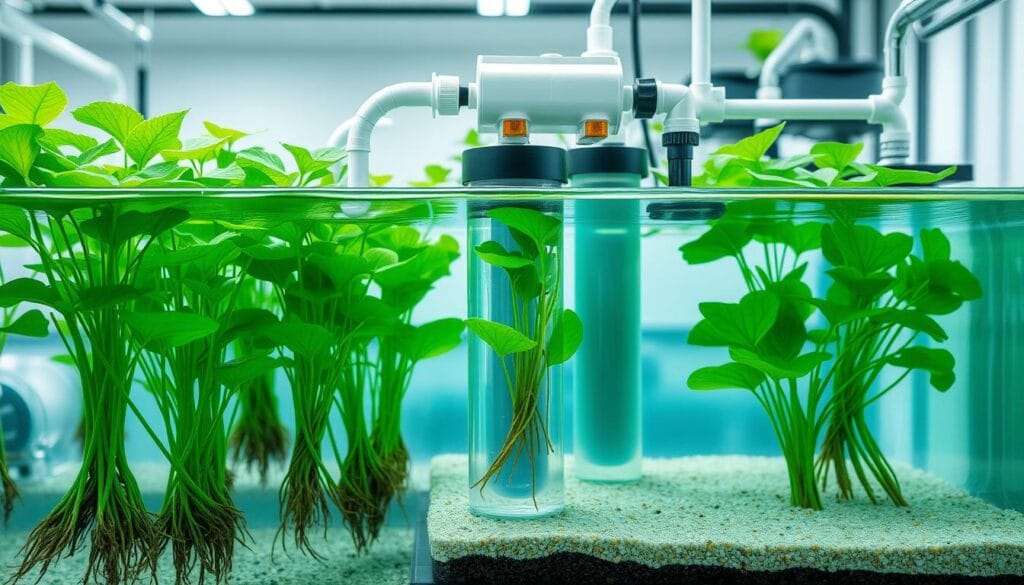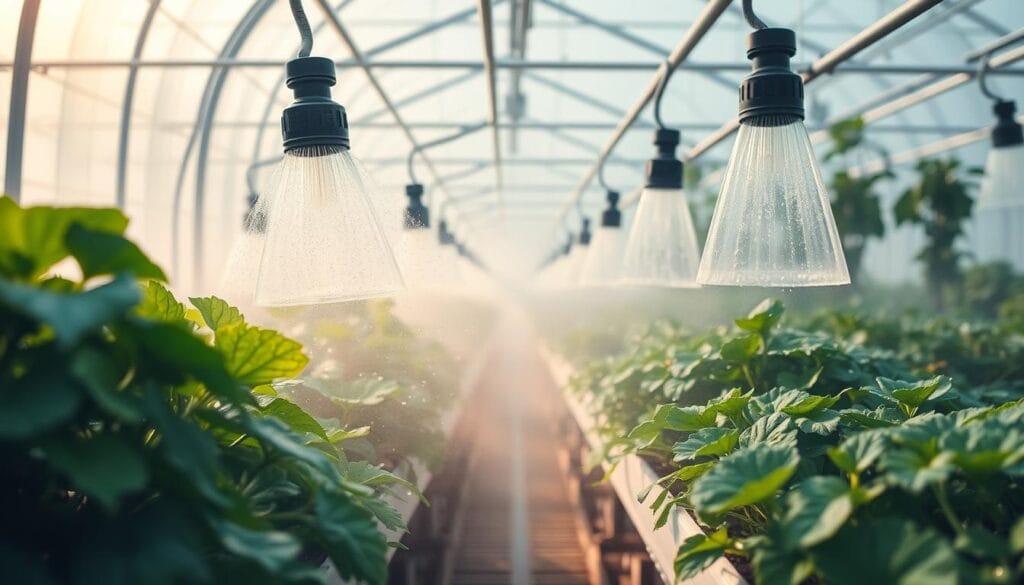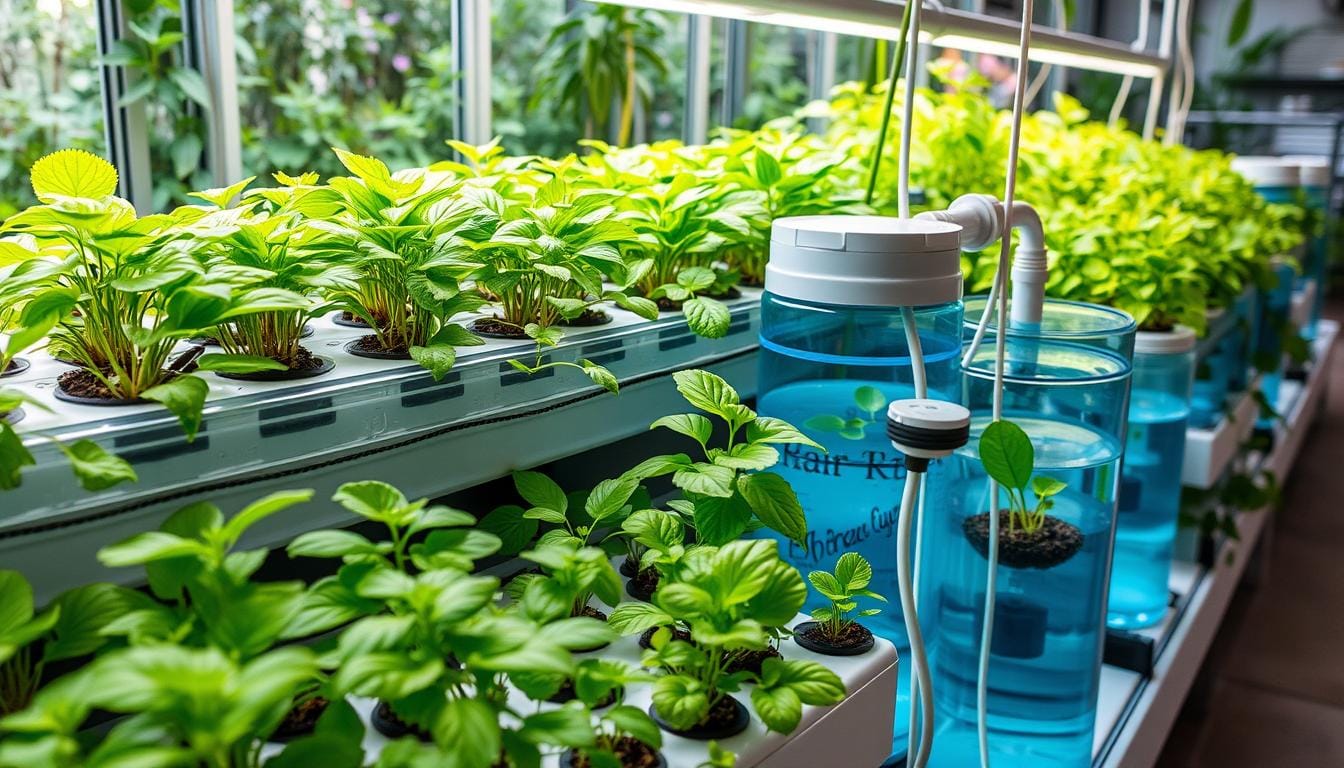I’ve always been fascinated by hydroponic farming. It’s incredible to grow plants without soil, but I often wondered how we can ensure it remains sustainable and eco-friendly.
Water is essential in hydroponics, providing plants with the nutrients they need. While hydroponics inherently uses less water than traditional farming, there is still potential for water wastage. My goal is to explore the best hydroponic water conservation techniques to make this innovative farming method even more efficient and environmentally friendly.
Key Takeaways
- Hydroponic systems can significantly reduce water usage compared to traditional soil-based agriculture.
- Proper nutrient solution management and recycling techniques can minimize water and nutrient waste.
- Advanced monitoring systems and automated irrigation controls optimize water efficiency in hydroponic setups.
- Innovative water treatment and recirculation methods help conserve water and maintain optimal growing conditions.
- Careful selection of water-efficient growing media and climate control strategies contribute to sustainable hydroponic practices.
Understanding Water Conservation in Hydroponics
Water conservation is key in sustainable hydroponics. It ensures we use resources wisely and lessen harm to the environment. Hydroponics, with its controlled growing space, uses water much more efficiently than traditional farming.
Importance of Water Management
Hydroponics can make crops grow 50% faster than old farming ways. This is because water and nutrients are given exactly as needed. This method also uses much less water, requiring only 10% of what traditional farming uses.
Environmental Impact of Water Usage
Too much water in farming can pollute, erode soil, and harm habitats. Hydroponics, with its closed systems, uses much less water. It also works well in dry places, using saltwater or recycled water, saving fresh water.
Economic Benefits of Conservation
Wasting water in farming costs a lot, especially in dry areas. Hydroponics saves money by using water wisely. It also cuts down on the need for lots of irrigation, making it cheaper to run.
Good water conservation is vital for everyone to have clean water. Hydroponics is a smart way to manage water, helping the planet, the wallet, and the community.
Different Types of Hydroponic Systems and Their Water Efficiency
Not all hydroponic systems save water equally. Knowing which ones are best can help you choose wisely. Let’s look at some common systems and how well they save water.
The Deep Water Culture (DWC) and Recirculating Deep Water Culture (RDWC) systems save some water. RDWC is a bit better because it recycles the nutrient solution. The Nutrient Film Technique (NFT) is very efficient. It uses a thin film of nutrient-rich water that flows over the roots.
The Ebb and Flow system is good for bigger plants. It delivers water and nutrients well. The Drip Irrigation system is also efficient but can be tricky to set up. The Wick System uses a cotton wick to bring nutrients to the roots, saving a lot of water.
Aeroponics isn’t strictly hydroponic but is the most water-efficient. It uses a fine mist of nutrients to feed the roots, which are suspended in the air.
| Hydroponic System | Water Efficiency |
|---|---|
| Deep Water Culture (DWC) | Moderately Efficient |
| Recirculating Deep Water Culture (RDWC) | Moderately Efficient (Slightly More Than DWC) |
| Nutrient Film Technique (NFT) | Highly Efficient |
| Ebb and Flow | Efficient for Large Plants |
| Drip Irrigation | Very Efficient but Complex to Set Up |
| Wick System | Highly Efficient |
| Aeroponics | Most Efficient |
Knowing how different hydroponic systems save water helps you choose wisely. This ensures your water-efficient hydroponics setup is both sustainable and productive.
Hydroponic Water Conservation Techniques
In hydroponic gardening, saving water is key for a sustainable system. Three main techniques help: recirculation, nutrient solution management, and evaporation control.
Recirculation Methods
Recirculation is vital for saving water in hydroponics. It reuses and refines nutrient solutions through filters. This cuts down water use and keeps nutrients balanced for plants.
Nutrient Solution Management
Managing nutrient solutions is crucial in hydroponics. Keeping pH and nutrient levels right prevents waste and boosts plant growth. Regular checks and tweaks to the solution ensure plants get what they need without wasting water.
Evaporation Control Strategies
Evaporation is a big water loss in hydroponics. Using materials like hydrogels and climate control can reduce evaporation. This keeps moisture levels right for plant health.
Using water recycling, nutrient solution management, and evaporation control methods helps hydroponic growers save a lot of water. These methods make hydroponics more sustainable and eco-friendly.
| Hydroponic Technique | Water Efficiency | Nutrient Management | Evaporation Control |
|---|---|---|---|
| Wick System | Moderate | Manual | Limited |
| Drip System | High | Automated | Moderate |
| Nutrient Film Technique | Very High | Automated | High |
The table shows how different hydroponic methods save water, manage nutrients, and control evaporation. It’s important to choose the right method for the best water conservation.
“Effective water management is the cornerstone of a thriving hydroponic system. By implementing innovative conservation techniques, growers can cultivate abundant harvests while minimizing their environmental impact.”
Advanced Water Monitoring Systems
In hydroponic farming, advanced water monitoring systems are key. They help use water wisely and sustainably. These systems use IoT sensors to track water levels, nutrient levels, and environmental conditions. This helps growers make smart choices and automate their work.
IoT sensors let hydroponic systems collect and analyze lots of data. This data helps control and optimize water use. Growers can adjust irrigation and nutrient levels for better plant health.
Automated irrigation controllers also help save water. They adjust watering based on plant needs and weather. This ensures plants grow well and healthily.
Using advanced water monitoring systems does more than save water. They help growers understand their operations better. This leads to better system efficiency and more productive plants.
“Advanced water monitoring systems are a game-changer for hydroponic growers, providing the data and control they need to maximize water usage optimization and grow healthier, more productive plants.”
As we need more sustainable food, using these systems will become more important. IoT technology helps growers save water, cut costs, and protect the environment. This leads to a greener future in indoor farming.
Implementing Smart Irrigation Controls
Improving water use in hydroponics is crucial for sustainable farming. Smart irrigation systems use automated watering, sensors, and schedules to save water. They keep growing conditions perfect.
Automated Watering Systems
Automated irrigation systems control water based on set rules and plant needs. They use sensors to check and adjust water supply. This prevents too much water and ensures plants get just the right amount.
Moisture Sensors and Controllers
Moisture sensors in the soil or growing media send data to the irrigation system. This lets the system adjust watering schedules. It waters only when needed, avoiding waste.
Schedule Optimization
Smart irrigation systems use advanced algorithms for better watering schedules. They adjust timing and duration based on plant needs and weather. This saves water, cuts down on runoff, and keeps crops healthy.
Using these smart irrigation systems, hydroponic farmers can use water more efficiently. They get better yields, lower costs, and a greener farming method.
Water Quality Management and Treatment
Keeping your hydroponic system’s water quality top-notch is key. You need to check and tweak the pH, electrical conductivity (EC), and nutrient levels often. Using methods like filtration, sterilization, and oxygenation can help keep your water perfect for your plants.
It’s important to balance the nutrients in your water solution. This guarantees your plants receive everything they need for healthy growth. Good water management leads to healthier plants, better yields, and saves water in your hydroponic setup.
Water Filtration and Purification
Having a good water filtration system is crucial. Mechanical filters get rid of solid stuff, while reverse osmosis or UV sterilization kill off bad microbes. Clean water means better plant growth and less chance of disease or nutrient problems.
pH Control and Monitoring
It’s vital to keep your hydroponic water’s pH between 5.5 and 6.5. This range is best for nutrient absorption and plant health. Regular pH checks and adjustments with pH up or down solutions keep your plants happy and healthy.
Nutrient Balance and Replenishment
Watching and adjusting your hydroponic system’s nutrient levels is critical. EC tests help you see when to add more nutrients. The right mix of macronutrients and micronutrients gives your plants the nutrients they need.
With good water quality management, your hydroponic system will flourish. It will grow plants well, save water, and use resources wisely. Healthy water is the base for a successful hydroponic setup.

“Proper water quality management is the cornerstone of a high-performing hydroponic system. It’s a game-changer for optimizing plant growth, water efficiency, and overall sustainability.”
Nutrient Solution Recycling Methods
In hydroponic systems, recycling nutrient solution is key to saving water. Growers use filters to clean the solution, making it safe to use again. Techniques like UV treatment kill harmful germs, keeping plants healthy.
Filtration Systems
Filtration systems are vital for recycling nutrient solution. They use different filters to get rid of dirt and harmful substances. This keeps the solution clean, saving water and money.
Sterilization Techniques
Sterilization is also important for keeping the solution safe. UV treatment and ozonation kill germs that could harm plants. This way, growers can safely reuse the solution, saving on water costs.
Nutrient Balance Maintenance
Keeping the nutrient balance right is crucial for recycling. Growers must test and adjust the solution often. This ensures plants get what they need, promoting healthy growth and saving resources.
By using recycling methods, growers can save a lot of water. This approach not only supports environmental sustainability but also leads to significant cost savings. It’s a win-win for everyone involved.
“IUsing a closed-loop nutrient recycling system can decrease water usage in hydroponic farming by as much as 90%.”
Climate Control and Water Conservation
Keeping the right humidity and temperature is key for saving water in hydroponics. Good climate control cuts down on water lost to evaporation and transpiration. This helps save this valuable resource.
Using shade cloths, adjusting air flow, and fine-tuning light can help. These steps keep plants healthy and growing well, using less water. By controlling the environment, you support plant health without wasting water.
In California, 2012-2014 were the driest years in over 100 years. This shows how vital water-saving growing methods are. Hydroponics can cut water use by more than half compared to outdoor farming.
“CEA methods can result in indoor farms using 70-90% less water compared to outdoor farms producing the same yield.”
Greenhouse tomatoes use recirculating hydroponics, saving a lot of water. This method can make water use 300-1000% better than field tomatoes. Also, drip irrigation can double tomato plant water use efficiency.
By using these methods, hydroponic growers can lower their environmental impact. They also gain from being more efficient and productive. These sustainable practices are essential as food demand grows and water becomes scarcer.

Water-Efficient Growing Media Selection
In hydroponic systems, the growing media you choose is key to saving water. Different types, like rockwool, coco coir, perlite, and clay pebbles, hold water differently. This affects how much water you use.
Different Media Types
Rockwool is great for holding water, making it good for saving water. Coco coir is a green option that also holds water well and lets roots breathe. Perlite helps with drainage and air, while clay pebbles support roots in deep water systems.
Water Retention Properties
The media’s ability to hold water is key to how often you need to water. Media like rockwool and coco coir need less water, saving you a lot. But, perlite and clay pebbles might need more water to stay moist.
Media Maintenance
Keeping your media clean and fresh is vital for saving water. Regular upkeep ensures it works well, holding water and nutrients for your plants. This way, you save water and help your plants grow strong.
When picking media, think about your plants, system design, and water-saving goals. Choose media that holds water well and maintain it well. This will help your hydroponic system use less water.
| Growing Media Type | Water Retention Properties | Suitable Hydroponic Systems |
|---|---|---|
| Rockwool | High water-holding capacity | Deep Water Culture (DWC), Nutrient Film Technique (NFT) |
| Coco Coir | Excellent water retention, good aeration | Ebb and Flow, Drip Systems |
| Perlite | Lightweight, promotes drainage and aeration | Ebb and Flow, Drip Systems |
| Clay Pebbles | Excellent for root support, moderate water retention | Deep Water Culture (DWC) |
“Hydroponic systems promote faster growth rates compared to traditional soil-based methods, while using significantly less water due to recirculation systems.”
Preventing Water Loss in Hydroponic Systems
Keeping water in your hydroponic system is key for growing crops sustainably. By stopping water loss, your hydroponic setup can work better and be kinder to the environment.
Regular System Maintenance
It’s important to check your hydroponic system for leaks often. Fixing any damage quickly can stop a lot of water from being lost. Having a regular maintenance plan helps catch problems early.
Evaporation Control Strategies
Evaporation is a big problem in hydroponic systems. Using covers or lids on nutrient solution reservoirs can cut down on evaporation. Also, insulating pipes and reservoirs keeps temperatures steady, which reduces evaporation and condensation.
| Hydroponic Technique | Typical Water Savings |
|---|---|
| Nutrient Film Technique (NFT) | Up to 90% water savings compared to traditional agriculture |
| Deep Water Culture (DWC) | Highly efficient, with water savings of 80-90% |
| Ebb and Flow (Flood and Drain) | Moderate water savings of 60-80% compared to soil-based farming |
The table shows how different hydroponic methods save water. These systems use much less water than farming with soil.
System Design Optimization
Designing your hydroponic system well can also save water. Use less water by covering more surfaces and using efficient irrigation like drip systems. Also, choose water-saving growing media like coco coir or perlite.
By using leak prevention, evaporation control, and system maintenance methods, you can make your hydroponic system more water-efficient. This makes it better for the planet and more sustainable.
Modern Technologies for Water Usage Optimization
The future of hydroponic farming is being shaped by new technologies. Artificial Intelligence (AI) and machine learning are key. They help analyze big data to make hydroponic operations more water-efficient and improve crop performance.
These advanced tools allow for precise control over irrigation and nutrient dosing. They also manage environmental parameters. This ensures your hydroponic system works at its best. By using data to make decisions, you can cut down water use while boosting plant growth and yield.
Adding renewable energy like solar or wind power also makes your hydroponic system more sustainable. This reduces your need for traditional power sources. It also lowers your carbon footprint, helping make agriculture more eco-friendly.

